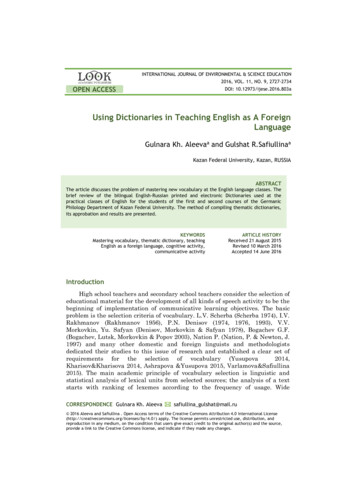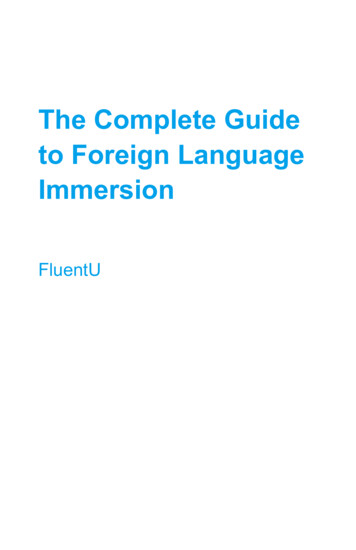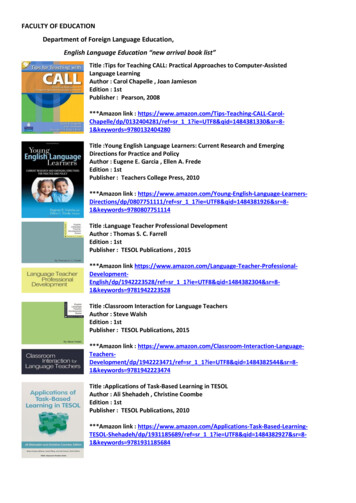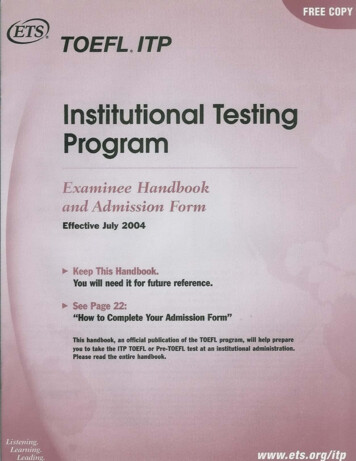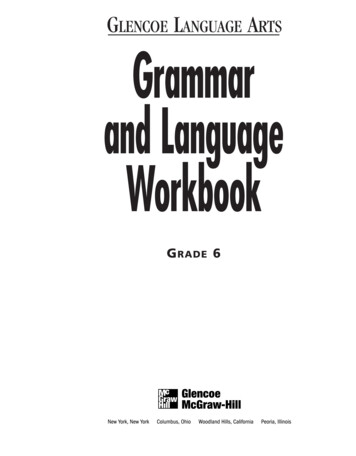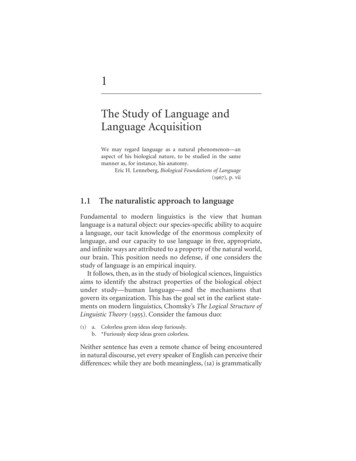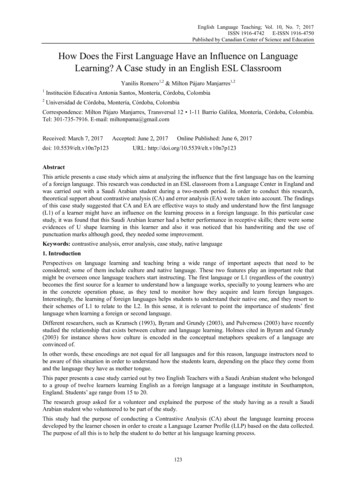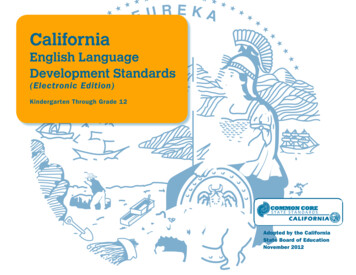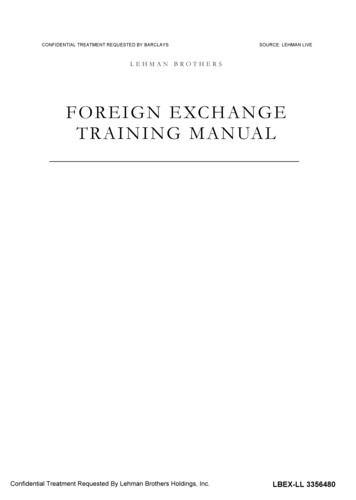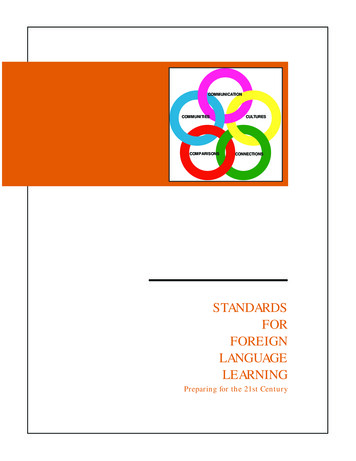
Transcription
IONSSTANDARDSFORFOREIGNLANGUAGELEARNINGPreparing for the 21st Century
Language and communication are at theheart of the human experience. TheUnited States must educate students whoare linguistically and culturally equippedto communicate successfully in a pluralistic American society and abroad. Thisimperative envisions a future in whichALL students will develop and maintainproficiency in English and at least oneother language, modern or classical.Children who come to school from nonEnglish backgrounds should also haveopportunities to develop further proficiencies in their first language.In 1993, a coalition offour national language organizations (the AmericanCouncil on the Teaching ofForeign Languages, theAmerican Association ofTeachers of French, theAmerican Association ofTeachers of German, andthe American Association ofTeachers of Spanish andPortuguese) received funding to develop standardsfor foreign language education, grades K-12.This was the seventhand final subject area toreceive federal support toStatement of Philosophydevelop national standardsStandards for Foreign Language Learningas part of the Bush Administration’s America 2000education initiative, whichcontinued under Goals 2000 in the Clinton Administration. An eleven-member taskforce, representing a variety of languages, levels of instruction, program models, andgeographic regions, was appointed to undertake the task of defining content standards—what students should know and be able to do—in foreign language education.At each stage of development, the task force shared its work with the broader profession and the public at large. The resulting document represents an unprecedentedconsensus among educators, business leaders, government, and the community on thedefinition and role of foreign language instruction in American education.The standards do not describe the current status of foreign language education inthis country. While they reflect the best instructional practice, they do not describewhat is being attained by the majority of foreign language students. The Standards forForeign Language Learning will not be achieved overnight; rather, they provide a gaugeagainst which to measure improvement in the years to come.The standards are not a curriculum guide. While they suggest the types of curricular experiences needed to enable students to achieve the standards, and support theideal of extended sequences of study that begin in the elementary grades and continue through high school and beyond, they do not describe specific course content, norrecommended sequence of study. They must be used in conjunction with state andlocal standards and curriculum frameworks to determine the best approaches and reasonable expectations for the students in individual districts and schools.
The purposes and uses of foreign languages are as diverse as thestudents who study them. Some students study another language inhopes of finding a rewarding career in the international marketplaceor government service. Others are interested in the intellectual challenge and cognitive benefits that accrue to those who master multiple languages. Still others seek greater understanding of other people and other cultures. Many approach foreign language study, asthey do other courses, simply to fulfill a graduation requirement.Regardless of the reason for study, foreign languages have something to offer everyone. It is with this philosophy in mind that thestandards task force identified five goal areas that encompass all ofthese reasons: Communication, Cultures, Connections, Comparisons, and Communities—the five C’s of foreign language education.The Five C’s ofForeign LanguageEducationCommunication is at the heart of second language study,whether the communication takes place face-to-face, in writing,or across centuries through the reading of literature.CommunicationThrough the study of other languages, students gain aknowledge and understanding of the cultures that use that language and, in fact, cannot truly master the language until theyhave also mastered the cultural contexts in which the languageoccurs.CulturesLearning languages provides connections to additional bodies of knowledge that may be unavailable to the monolingualEnglish speaker.ConnectionsThrough comparisons and contrasts with the languagebeing studied, students develop insight into the nature of language and the concept of culture and realize that there are multiple ways of viewing the world.ComparisonsTogether, these elements enable the student of languages toparticipate in multilingual communities at home and aroundthe world in a variety of contexts and in culturally appropriateways.Communities“Knowing how, when, and why to say what to whom”All the linguistic and social knowledge required for effective human-to-human interaction is encompassed in those ten words. Formerly, most teaching in foreign language classrooms concentrated on the how (grammar) to say what (vocabulary).While these components of language are indeed crucial, the current organizing principle for foreign language study is communication, which also highlights the why, thewhom, and the when. So, while grammar and vocabulary are essential tools for communication, it is the acquisition of the ability to communicate in meaningful andappropriate ways with users of other languages that is the ultimate goal of today’s foreign language classroom.
Standards Connect with Other Disciplines andAcquire InformationStandard 3.1: Students reinforce and further their knowledge of other disciplinesthrough the foreign language.Standard 3.2: Students acquire informationand recognize the distinctive viewpointsthat are only available through the foreignlanguage and its cultures.Communicate in LanguagesOther Than EnglishStandard 1.1: Students engage in conversations, provide and obtain information,express feelings and emotions, and exchangeopinions.Standard 1.2: Students understand andinterpret written and spoken language ona variety of topics.Standard 1.3: Students present information, concepts, and ideas to an audience oflisteners or readers on a variety of topics.CulturesGain Knowledge andUnderstanding of Other CulturesStandard 2.1: Students demonstrate anunderstanding of the relationship betweenthe practices and perspectives of the culture studied.Standard 2.2: Students demonstrate anunderstanding of the relationship betweenthe products and perspectives of the culture studied.ComparisonsDevelop Insight into the Nature ofLanguage and CultureStandard 4.1: Students demonstrate understanding of the nature of language through comparisons of the language studied and their own.Standard 4.2: Students demonstrate understanding of the concept of culture through comparisons of the cultures studied and their own.CommunitiesParticipate in Multilingual Communitiesat Home & Around the WorldStandard 5.1: Students use the languageboth within and beyond the school setting.Standard 5.2: Students show evidence ofbecoming life-long learners by using thelanguage for personal enjoyment andenrichment.
Following is an abbreviated sample of the goals, standards, and progress indicators for grades four, eight, and twelveas they appear in “Standards for Foreign Language Learning: Preparing for the 21st Century.”COMMUNICATION1.1Students engage in conversations, provide and obtain information, express feelings and emotions,and exchange opinions.This standard focuses on interpersonal communication, that is, direct oral or written communication between individuals who are in personal contact. In most modern languages, studentscan quite quickly learn a number of phrases that will permit them to interact with each other.In the course of their study, they will grow in their ability to converse in a culturally appropriate manner.Sample Progress IndicatorsGrade 4: Students ask and answer questions about such things as family, schoolevents, and celebrations in person or vialetters, e-mail, or audio and video tapes.1.2Grade 8: Students exchange informationabout personal events, memorable experiences, and other school subjects with peersand/or members of the target cultures.Grade 12: Students exchange, support, anddiscuss their opinions and individual perspectives with peers and/or speakers of the targetlanguage on a variety of topics dealing withcontemporary and historical issues.Students understand and interpret written and spoken language on a variety of topics.Standard 1.2 involves one-way listening and reading in which the learner works with a varietyof print and non-print materials. The context in which the language is experienced and the ability to control what they hear and read may impact students’ development of comprehension. Asa result, the ability to read may develop before the ability to comprehend rapid spoken language.In addition, content knowledge will often affect successful comprehension, for students understand more easily materials that reflect their interests or for which they have some background.Sample Progress IndicatorsGrade 4: Students comprehend the mainidea of developmentally appropriate oralnarratives such as personal anecdotes, familiar fairy tales, and other narratives based onfamiliar themes.1.3Grade 8: Students use knowledge acquired inother settings and from other subject areas tocomprehend spoken and written messagesin the target languages.Grade 12: Students demonstrate an increasingunderstanding of the cultural nuances ofmeaning in written and spoken language asexpressed by speakers and writers of the targetlanguage in formal and informal settings.Students present information, concepts, and ideas to an audience of listeners or readers on a variety of topics.This standard focuses on the formal presentation of information, concepts, and ideas in spokenand written form and is concerned, in most cases, with one-way speaking and writing. Studentswith little or no previous language experience are likely to produce written and spoken language that will contain a variety of learned patterns or will look like English with words in theother language. This is a natural process and, over time, they begin to acquire authentic patternsand to use appropriate styles. By contrast, home-background students will write in ways thatclosely resemble the spoken language. Moreover, they will control informal oral styles. Overtime these learners will develop the ability to write and speak using more formal styles.Sample Progress IndicatorsGrade 4: Students prepare illustrated stories about activities or events in their environment and share with an audience suchas the class.Grade 8: Students prepare tape or videorecorded messages to share locally or withschool peers and/or members of the targetcultures on topics of personal interest.Grade 12: Students prepare a researchbased analysis of a current event from theperspective of both the U.S. and target cultures.
CULTURES2.1 Students demonstrate an understanding of therelationship between the practices and perspectives of the culture studied.This standard focuses on the practices that arederived from the traditional ideas and attitudes (perspectives) of a culture. Cultural practices refer to patterns of behavior accepted by a society and deal withaspects of culture such as rites of passage, the use offorms of discourse, the social “pecking order,” andthe use of space. In short, they represent the knowledge of “what to do when and where.”2.2Students demonstrate an understanding of therelationship between the products and perspectives of the culture studied.This standard focuses on the products of the culture studiedand on how they reflect the perspectives of the culture.Products may be tangible (e.g., a painting, a piece of literature,a pair of chopsticks) or intangible (e.g., an oral tale, a dance, asacred ritual, a system of education). Whatever the form of theproduct, its presence within the culture is required or justifiedby the underlying beliefs and values (perspectives) of that culture, and the cultural practices involve the use of that product.CONNECTIONS3.1Students reinforce and further their knowledgeof other disciplines through the foreign language.Learning today is no longer restricted to a specific discipline; it has become interdisciplinary. Just as readingcannot be limited to a particular segment of the schoolday, so too can foreign language build upon theknowledge that students acquire in other subjectareas. In addition, students can relate the informationstudied in other subjects to their learning of the foreign language and culture. Foreign language instruction thus becomes a means to expand and deepenstudents’ understanding of, and exposure to, otherareas of knowledge. The new information and concepts presented in one class become the basis of continued learning in the foreign language classroom.3.2Students acquire information and recognize thedistinctive viewpoints that are only availablethrough the foreign language and its cultures.As a consequence of learning another language andgaining access to its unique means of communication, students are able to broaden the sources of information available to them. They have a “new windowon the world.” At the early levels of language learning, students can begin to examine a variety ofsources intended for native speakers, and extract specific information. As they become more proficientusers of the foreign language, they can seek out materials of interest to them, analyze the content, compareit to information available in their own language, andassess the linguistic and cultural differences.COMPARISONS4.1Students demonstrate understanding of thenature of language through comparisons ofthe language studied and their own.This standard focuses on the impact that learning thelinguistic elements in the new language has on students’ ability to examine English and to develophypotheses about the structure and use of languages.From the earliest language learning experiences, students can compare and contrast the two languages asdifferent elements are presented. Activities can besystematically integrated into instruction that willassist students in gaining understanding and indeveloping their abilities to think critically abouthow languages work.4.2Students demonstrate understandingof the concept of culture through comparisonsof the cultures studied and their own.As students expand their knowledge of culturesthrough language learning, they continually discoverperspectives, practices, and products that are similarand different from their own culture, and they develop the ability to hypothesize about cultural systems ingeneral. Some students may make these comparisonsnaturally, others may not. This standard helps focusthis reflective process for all students by encouragingintegration of this process into instruction from theearliest levels of learning.
COMMUNITIES5.1Students use the language both within andbeyond the school setting.This standard focuses on language as a tool for communication with speakers of the language throughout one’s life: in schools, in the community, andabroad. In schools, students share their knowledgeof language and culture with classmates and withyounger students who may be learning the language. Applying what has been learned in the language program as defined by the other standards,students come to realize the advantages inherent inbeing able to communicate in more than one language and develop an understanding of the powerof language.5.2Students show evidence of becoming lifelong learners by using the language for personal enjoyment and enrichment.Each day millions of Americans spend leisure timereading, listening to music, viewing films and television programs, and interacting with each other. Bydeveloping a certain level of comfort with their newlanguage, students can use these skills to access information as they continue to learn throughout theirlives. Students who study a language can use theirskills to further enrich their personal lives by accessing various entertainment and information sourcesavailable to speakers of the language. Some studentsmay have the opportunity to travel to communitiesand countries where the language is used extensivelyand, through this experience, further develop theirlanguage skills and understanding of the culture.SAMPLE LEARNING SCENARIO: NEWSCASTStandards Targeted1.11.32.13.15.15.2Interpersonal CommunicationPresentational CommunicationPractices of CultureFurthering ConnectionsSchool and CommunityLife-long LearningDescriptionIn the Spanish II class in Williamston High School, a small, ruralcommunity in Michigan, students worked in groups to write, produce, and videotape a fifteen-to-twenty minute Spanish languagenews show that included news events; a live, from-the-scene report;weather; sports; and commercials. The news events included itemsfrom the Spanish-speaking world, the United States, the state, andlocal areas.Reflection1.1—Students work cooperatively in groups using the language to produce the newscast.1.3—Students produce the newscast in the language studied.2.1—Students present news stories that reflect a perspective from the culture studied.3.1—Students develop news items on a variety of topics.5.1—Students use the language in the classroom.5.2—Students develop insights necessary for media literacy.If the students were asked to view taped newscasts and commercials from two Spanish speaking countriesand use them as models for their project, an emphasis could be placed on Standards 1.2 and 4.1 (in preparing for the project, students view newscasts and compare and contrast language styles) and Standard 4.2(students note cultural similarities and differences in the videotapes they viewed). This type of preparationfor the project would also provide the opportunity to target Standard 2.2 with students analyzing a productof the culture studied. This scenario could be applied to any language at a variety of levels.
700 S. Washington St., Suite 210Alexandria, VA 22314
Teachers of French, the American Association of Teachers of German, and the American Association of Teachers of Spanish and Portuguese) received fund-ing to develop standards for foreign language educa-tion, grades K-12. This was the seventh and final subject area to receive federal support


